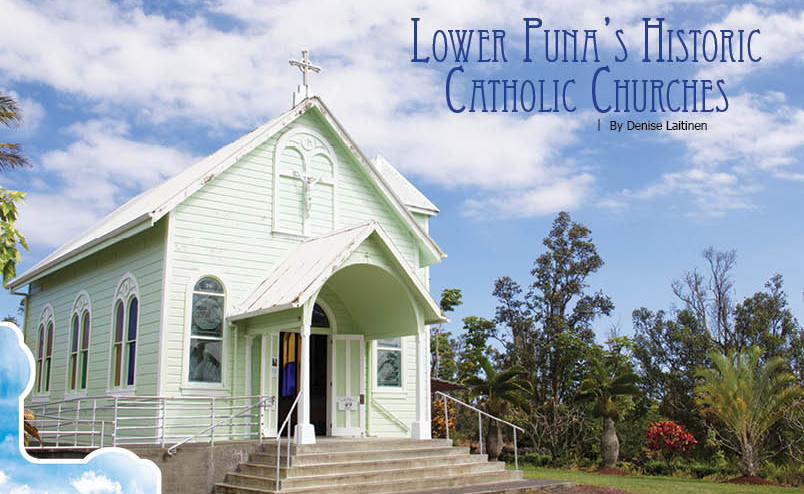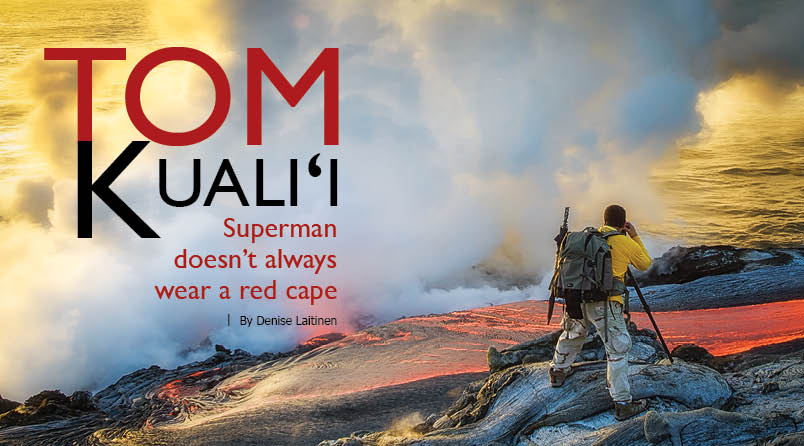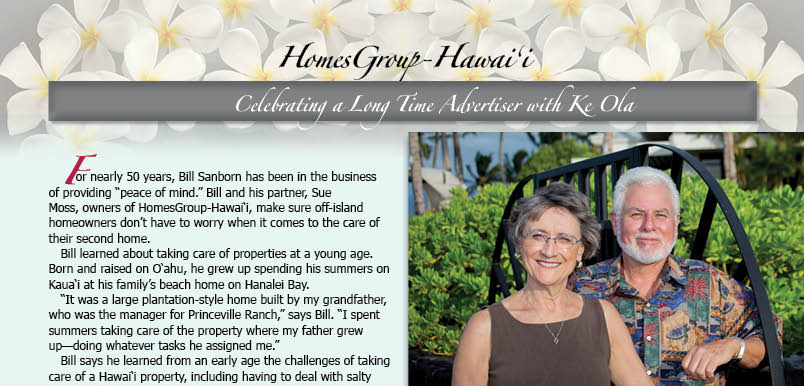
Lower Puna’s Historic Catholic Churches

By Denise Laitinen
From the outside, the Star of the Sea, a modest green church sitting on the side of the road in Kaimū looks unassuming. It is simple in design, small in size, and its paint is peeling.
Just as an oyster’s plain shell hides a lustrous pearl within, so too does Star of the Sea Church. To step inside this house of worship is to step into a jewel of a building rich in history, culture, and color. Here stain glass windows featuring the images of Father Damien and Mother Marianne Cope sparkle in the sun. Murals and paintings depicting Bible scenes, Kalapana’s history, and local legends encompass nearly every square inch of the church’s interior.
Star of the Sea Church is important for a variety of reasons. One of the few buildings to survive the lava flow that destroyed Kalapana in 1990 (thanks to the efforts of several community members), it is also one of the few remaining examples of folk art by Father Evarist Gielen.
After arriving in Puna in 1927, Belgian missionary priest Father Evarist Gielen, or Father Evarist as he is still referred to locally, embarked on a building spree. Assigned to Sacred Heart Church in Pāhoa, he built the church and a rectory at its current location in the heart of downtown Pāhoa (the church had previously been located further away on Pāhoa Village Road.)
Father Damien DeVeuster is credited with building the first thatched church in Kapa‘ahu, a few miles from Kalapana, after the Belgian native arrived on Hawai‘i Island as a newly ordained priest in 1864. During his time in Puna, Father Damien is said to have built several chapels, all made from materials he found nearby, such as bamboo, pili grass, and coconut fronds. [After leaving Hawai‘i Island, Father Damien travelled to Moloka‘i where his work with patients of Hansen’s disease—or leprosy—resulted in him being canonized as Saint Damien in 2009.]
Once Sacred Heart Church and its rectory were completed, Father Evarist set about building a more permanent church for residents in Kalapana. With a small budget he bought land near the shoreline in the heart of Kalapana, about a half-mile down the coast from where Uncle Robert’s market is now. Using lumber left over from Sacred Heart church and with the help of nearby residents, Father Evarist built Star of the Sea church, a gymnasium, and a small house in about seven months.
With construction completed, the priest set about painting murals of Bible scenes on the church’s ceiling. Working at night by the light of a kerosene lantern, it took him four-and-a-half months to complete the murals. On April 19, 1931, the church was formally dedicated and named Star of the Sea, because of the important role the ocean played in the lives of Kalapana residents.
“Star of the Sea was built as a mission church for Sacred Heart,” says Bernice Walker, who was born and raised in Kalapana. Bernice grew up attending Star of the Sea and now works as the secretary for Sacred Heart.
Both Sacred Heart and Star of the Sea churches played pivotal roles in the community. According to George Salazar, a long time member of Sacred Heart church, a community hall used to stand fronting Pāhoa Village Road, where the parking lot for the Montessori school is today, and was a frequent site of weddings and community events. The churches provided activities for kids and adults with youth groups as well as a Society of the Sacred Heart for women.
During the 1930s in Kalapana, Father Evarist organized basketball and volleyball teams for both boys and girls with teams competing against groups as far away as Honoka‘a.
In addition to being a community hub, Star of the Sea also attracted other painters. During the early 1960s, Georgia artist George Heidler met Father McGinn, who was in charge of Sacred Heart at the time. At McGinn’s invitation Heidler created 14 Stations of the Cross from koa wood and painted the lower walls of Star of the Sea church. Indeed, many online sites erroneously give Heidler as much credit as Father Evarist when discussing the historic church.
However, the original artist was apparently unimpressed with Heidler’s work. In the spring of 1975, Father Evarist revisited Kalapana and spent three months repainting and touching up the murals he had created 45 year earlier.
“When Father Evarist came back he painted over a lot of what George Heidler did,” says Bernice.
A couple years later, Hilo artist George Lorch was invited to add artwork to the church walls. Lorch painted several scenes, including one of Father Damien’s first church in Kalapana, and wrote verses in Hawaiian that can still be seen on the church walls.
The 1970s were a key time for the church in other respects as well. In 1977, lava from Kīlauea’s east rift zone threatened Kalapana. At the time, volcanologists advised church officials to move Star of the Sea. Fortunately, the lava stopped 3,400 feet from the structure and the church remained in place.
During this period, both parishes were thriving. The development of several area subdivisions, including Hawaiian Paradise Park, Leilani Estates, Hawaiian Beaches, and Ainaloa started to increase, as did the size of the congregations. Both churches received new roofs and other improvements, such as stained glass windows. Sacred Heart Church was expanded to make more seats available during mass and a portico was added to the front. Even when the sugar plantations packed up and moved away, the churches remained an important part of the community.
The plain wooden structure of Star of the Sea, however, proved to be no match for Mother Nature. In May 1990 lava once again threatened Kalapana. Again, the issue of whether or not to move the church was raised. Recalling that time, Bernice says parishioners were at odds on the issue.
“It [the congregation] was very divided on whether to move the church or not move it,” she says. “What led to it moving was that there was free help.”
With the approval of Bishop Ferrario of the Honolulu Archdiocese, community members moved the church themselves on a flatbed truck.
“Parishioners from Pāhoa and Kalapana were the ones that shored the building up, braced it, and put it on the trailer,” adds Bernice. At the time, parishioners weren’t even sure where the church would end up; the focus was just to get it out of harm’s way.
The church remained at a temporary location for a few years until church officials could negotiate a permanent site for it. The altar from Star of the Sea was moved to Sacred Heart church and many parishioners, themselves displaced by the lava, started attending the Pāhoa church.
Star of the Sea was eventually moved to its current location in Kaimū, near Kalapana, on Highway 130 between the 19 and 20 mile markers.
A retrospective booklet on the history of both churches quotes Agnes Kaawaloa as saying, “as the Church was being lowered to solid ground a rainbow formed right above the church. Me, my husband [Edmund], and Luella Pe‘a all witnessed this rainbow. This occurrence was interpreted to mean ‘put the church there…she belongs there.’”
Because the church was moved from its original site and its holy relics were removed, the Honolulu Archdiocese officially decommissioned the church in 1995. Mass and even weddings are still held at Star of the Sea, although any services now require permission from the Bishop of the Honolulu Archdiocese. Services were held sporadically after the church was moved and for the past eight years a Mass has been held at Star of the Sea on the first Friday of every month at 4pm.
Since it was moved to its current location, Star of the Sea has been cared for by a small group of individuals known as the Kalapana Ohana Association, (KOA), a 501(c) 3 nonprofit group. The group relies entirely on donations to keep the church doors open so that residents and visitors alike can enjoy the beauty of the church. In 1997, the church was added to the National Register of Historic Places in order to help with its preservation.
Rosana Kanoa is one of the members of the Kalapana Ohana Association. She’s been active in the church since her company, Big Island Processing, set up shop in 2005 across the street from Star of the Sea. At the time, she noticed the church lawn was not being maintained. Rosana became more and more involved in the church and even paid $3,000 needed for the church’s liability insurance.
Pancho Aldana, who also works at Big Island Processing, is the de facto caretaker of the church, ensuring that the church is open to the public every day between 9am–4pm.
“Many people come from different countries to see the paintings, and especially from Belgium,” says Pancho, a reference to the Belgian heritage of Saint Damien and Father Evarist.
“The paintings can’t be replaced,” adds Rosana.
Sadly, while its parishioners and tourists who stop at the historical site revere the church, it does not receive the same respect from all visitors.
“This area has a lot of transient people,” says Rosana. Although the church is locked and gated at night, this local treasure has been subject to vandalism and theft. As caretaker, Pancho is usually the one to discover the unexpected visitors and surprises.
Perhaps most painful to the Kalapana Ohana Association members is the vandalism and theft. One of the stained glass windows is currently covered with plywood because someone threw a rock through it, says Rosana. Pancho adds that the locked donation box has been broken into multiple times over the years. Given the meager resources of the small church and its reliance on donations from visitors, the thefts hit hard.
Kalapana Ohana Association has held several types of fundraisers. Pancho said at one point he was raising and selling pigs to help pay for the church’s expenses. Currently, the group is looking for a stained glass artist to help them replace the broken window as well as folk artists willing to help restore the frescos.
Despite the struggles, the group hopes to keep this gem of a church operating for many years in the future.
Before she passed away several years ago, well-known Kalapana resident Emma K. Stone Kauhi summed up the importance of Star of the Sea church. Born in nearby Kapa‘ahu, Emma once told a church historian, “people have told me Kalapana is gone…well, maybe the land is gone, Queen’s bath is gone, the Protestant church is gone, Kaimū’s famous black sand beach is gone.…but we have one more symbol….Star of the Sea Church. That’s one more symbol we are hanging on to. Hopefully we can keep it for a long time.” ❖
Contact the writer and photographer
Star of the Sea
Located on Hwy 130 between the 19 and 20 mile markers.
Open every day 9am–4pm. No admission charge, donations are welcome and can be mailed to: Kalapana Ohana Association, PO Box 5026, Hilo, HI 96720
Mass is offered the first Friday of every month at 4pm.
808.965.8202
Sacred Heart Church
Mass is offered: Tuesday–Saturday 8am, Saturday at 5pm, and Sunday at 7am, 8:30am, and 10:30am
15-3003 Pāhoa Village Road, Pāhoa
808.965.8202


